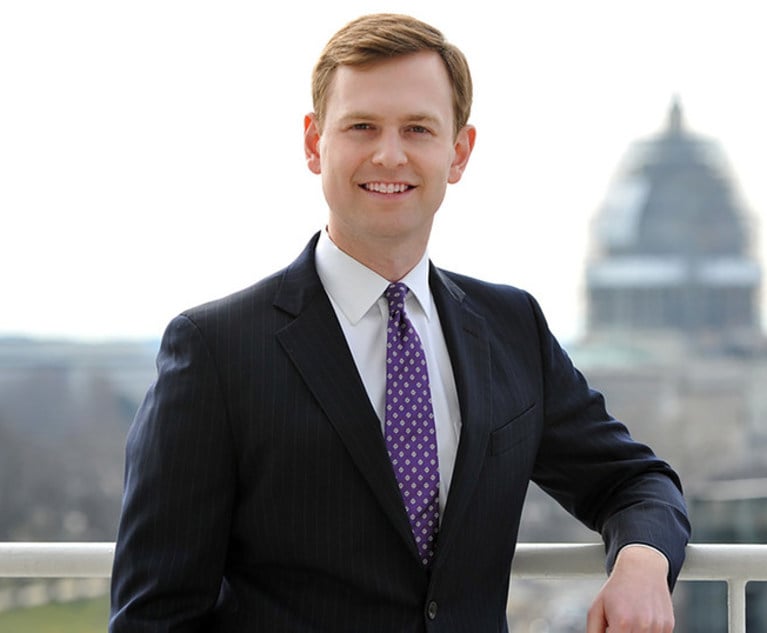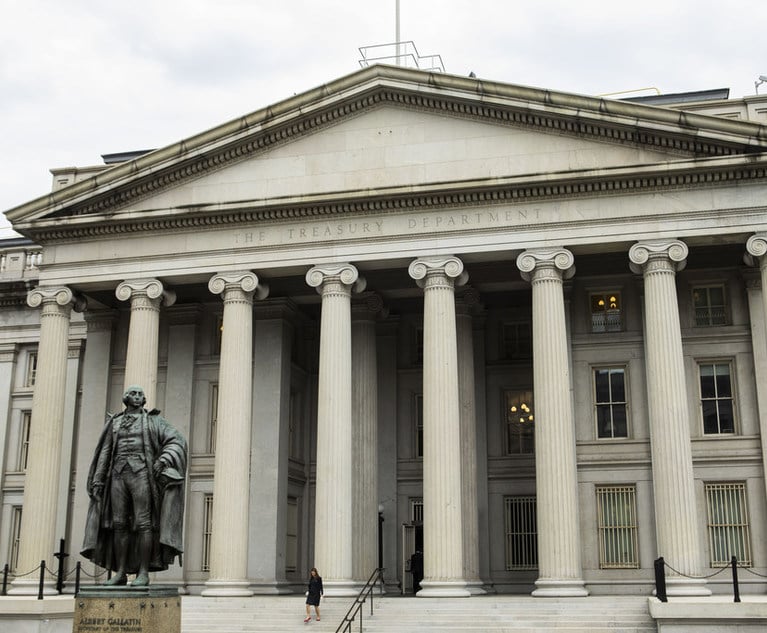Regulatory: Patent office secrecy orders for commercial inventions may stifle development
In 1999, Congress passed the American Inventors Protection Act (AIPA), which provided, among other provisions, that U.S. patent applications would be published 18 months after filing.
January 23, 2013 at 06:38 AM
5 minute read
The original version of this story was published on Law.com
In 1999, Congress passed the American Inventors Protection Act (AIPA), which provided, among other provisions, that U.S. patent applications would be published 18 months after filing. This provision was designed to bring the U.S. patent process into harmonization with patent procedures in other major world markets, including Europe and Japan. It was also said to be necessary in order to prevent inventors from intentionally delaying issuance of patents until markets developed, a scheme often described as “submarine” patenting.
One issue that has arisen as a result of the 18 month publication provision is that inventions are published long before enforceable patents are issued by the U.S. Patent Office (PTO). The average pendency of a U.S. patent application was 33.7 months in 2011. As a result, on average, there was a 15.7 month gap between worldwide disclosure of the invention and the issuance of enforceable patent rights protecting that invention.
Last year a congressional committee directed the PTO to study the possibility of special treatment for patents that potentially affect “economic security.” Congress' stated purpose was to “ensure that the United States receives the first benefits of innovations conceived within this country, so as to promote domestic development, further innovation and continued economic expansion.”
The suggested mechanism is similar to that used to control publication of patent applications for sensitive defense and nuclear technology. Patent applications which may include such sensitive information are reviewed by a panel of military and defense agencies. If it is determined the patent application includes sensitive material, the PTO issues a “secrecy order.” The secrecy order prevents publication of the application and tightly restricts an applicants' right to file for patents in foreign countries. Secrecy orders also work hand-in-hand with other export control mechanisms, preventing sale and commercialization of inventions that have defense implications, especially outside the U.S.
Secrecy orders are indefinite in length. A patent does not issue while a secrecy order is in effect. There are currently about 5,000 patent applications under secrecy order. Since 2000, fewer than 100 secrecy orders have been rescinded in any one year. As a practical matter, most of the applications under secrecy order are likely owned by defense contractors whose sole customer is the U.S. government. Therefore, the existence of a secrecy order is not a significant detriment to patent owners in those cases.
But what would happen if secrecy orders were expanded to include economic security. Which inventions would be determined to affect economic security? Would they include Apple's next i-device, a biotech cure for a form of cancer or perhaps new energy development technology? Could the PTO arbitrarily issue secrecy orders, perhaps to hamper the development of technologies not favored by the government?
On April 20, 2012, the PTO requested comments on the proposal to screen patent applications for economic security effects. Industry organizations, patent attorney organizations, companies and universities responded. The comments were overwhelmingly negative, although there were some supporters of the concept. It was pointed out that economic secrecy orders would significantly impair the commercialization of the product. Such rules would have the perverse effect of more seriously impacting the most valuable and widespread technologies. Multiple commentators pointed out the rules would hamstring U.S. interests in the global marketplace because patent filing and disclosure outside the U.S. would be prevented or limited.
One purpose of the patent system is to encourage disclosure of inventions in exchange for the issuance of patent rights which are limited in time. Inventors faced with the possibility of having valuable rights locked up by a secrecy order would be more likely to simply maintain their technology as a trade secret. This would be a detriment to technology development and undercut a key purpose of the patent system.
It was also pointed out a secrecy order regime would work against the original purpose of the AIPA, namely global harmonization. This proposed procedure is out of the global mainstream. A Japanese group raised the specter of a return of submarine patents, this time caused by placing patents under secrecy order for a period of time and then allowing them to issue when a market is fully developed.
There are already in place procedures to avoid patent publication. This proposal would replace a strategic choice by the inventor with a determination by government agencies, all to the detriment of commercialization of the invention.
The most thorough comment in support of the proposal was by “Anonymous.” This commentator believes economic security is just as important as national security and expressed a belief that controlling export of technology is key.
As pointed out by multiple commentators, the stated problem could be solved if the PTO could issue patents closer to the 18-month publication date. It was suggested that perhaps resources should be spent in increasing PTO effectiveness rather than imposing another regulatory scheme on the technology community.
The PTO continues to “study” the issue.
This content has been archived. It is available through our partners, LexisNexis® and Bloomberg Law.
To view this content, please continue to their sites.
Not a Lexis Subscriber?
Subscribe Now
Not a Bloomberg Law Subscriber?
Subscribe Now
NOT FOR REPRINT
© 2025 ALM Global, LLC, All Rights Reserved. Request academic re-use from www.copyright.com. All other uses, submit a request to [email protected]. For more information visit Asset & Logo Licensing.
You Might Like
View All
Internal Whistleblowing Surged Globally in 2024, So Why Were US Numbers Flat?
6 minute read
FTC Finalizes Child Online Privacy Rule Updates, But Ferguson Eyes Further Changes

Supreme Court Reinstates Corporate Disclosure Law Pending Challenge
Trending Stories
- 1We the People?
- 2New York-Based Skadden Team Joins White & Case Group in Mexico City for Citigroup Demerger
- 3No Two Wildfires Alike: Lawyers Take Different Legal Strategies in California
- 4Poop-Themed Dog Toy OK as Parody, but Still Tarnished Jack Daniel’s Brand, Court Says
- 5Meet the New President of NY's Association of Trial Court Jurists
Who Got The Work
J. Brugh Lower of Gibbons has entered an appearance for industrial equipment supplier Devco Corporation in a pending trademark infringement lawsuit. The suit, accusing the defendant of selling knock-off Graco products, was filed Dec. 18 in New Jersey District Court by Rivkin Radler on behalf of Graco Inc. and Graco Minnesota. The case, assigned to U.S. District Judge Zahid N. Quraishi, is 3:24-cv-11294, Graco Inc. et al v. Devco Corporation.
Who Got The Work
Rebecca Maller-Stein and Kent A. Yalowitz of Arnold & Porter Kaye Scholer have entered their appearances for Hanaco Venture Capital and its executives, Lior Prosor and David Frankel, in a pending securities lawsuit. The action, filed on Dec. 24 in New York Southern District Court by Zell, Aron & Co. on behalf of Goldeneye Advisors, accuses the defendants of negligently and fraudulently managing the plaintiff's $1 million investment. The case, assigned to U.S. District Judge Vernon S. Broderick, is 1:24-cv-09918, Goldeneye Advisors, LLC v. Hanaco Venture Capital, Ltd. et al.
Who Got The Work
Attorneys from A&O Shearman has stepped in as defense counsel for Toronto-Dominion Bank and other defendants in a pending securities class action. The suit, filed Dec. 11 in New York Southern District Court by Bleichmar Fonti & Auld, accuses the defendants of concealing the bank's 'pervasive' deficiencies in regards to its compliance with the Bank Secrecy Act and the quality of its anti-money laundering controls. The case, assigned to U.S. District Judge Arun Subramanian, is 1:24-cv-09445, Gonzalez v. The Toronto-Dominion Bank et al.
Who Got The Work
Crown Castle International, a Pennsylvania company providing shared communications infrastructure, has turned to Luke D. Wolf of Gordon Rees Scully Mansukhani to fend off a pending breach-of-contract lawsuit. The court action, filed Nov. 25 in Michigan Eastern District Court by Hooper Hathaway PC on behalf of The Town Residences LLC, accuses Crown Castle of failing to transfer approximately $30,000 in utility payments from T-Mobile in breach of a roof-top lease and assignment agreement. The case, assigned to U.S. District Judge Susan K. Declercq, is 2:24-cv-13131, The Town Residences LLC v. T-Mobile US, Inc. et al.
Who Got The Work
Wilfred P. Coronato and Daniel M. Schwartz of McCarter & English have stepped in as defense counsel to Electrolux Home Products Inc. in a pending product liability lawsuit. The court action, filed Nov. 26 in New York Eastern District Court by Poulos Lopiccolo PC and Nagel Rice LLP on behalf of David Stern, alleges that the defendant's refrigerators’ drawers and shelving repeatedly break and fall apart within months after purchase. The case, assigned to U.S. District Judge Joan M. Azrack, is 2:24-cv-08204, Stern v. Electrolux Home Products, Inc.
Featured Firms
Law Offices of Gary Martin Hays & Associates, P.C.
(470) 294-1674
Law Offices of Mark E. Salomone
(857) 444-6468
Smith & Hassler
(713) 739-1250







